In this article we will look into left hand driving for all of you who come from a right side driving country – like myself.
Page Contents (click line to jump the text)
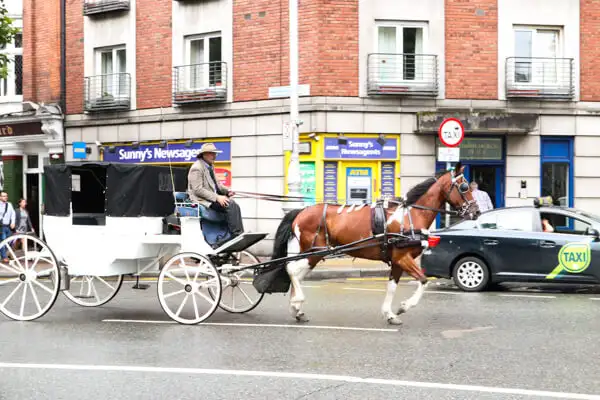
Intro
Disclaimer: Although I have some years’ experience as a road user on Irish roads, I am not a traffic law expert or driving instructor and am not authorised to give legally binding advice.
The following text is therefore not legally binding and does not claim to be complete. I am merely giving some tips from experience to make it easier to get used to driving on the left-hand side of the road in Ireland.
At the end of the text you will find references to local authorities where you can and should inform yourself about the applicable traffic laws in Ireland and Northern Ireland.
My family and I are from Germany, but have been living in Ireland (second home) for several years. Coming from right-hand-traffic, we have travelled Ireland a lot and learned a few things about the left-hand-traffic, too.
We have travelled extensively in Ireland, Northern Ireland and Great Britain, and of course we travel a lot on the left.
Driving on the Left in Ireland – Contents:
1) Republic of Ireland is not Northern Ireland
2) Direction of travel, overtaking and turning
3) Starting / moving off
4) Right of way
5) One-way streets
6) Road markings
7) Roundabouts
8) Motorways
9) Parking and parking bans
10) Alcohol
11) Speeds in the Republic of Ireland
12) Speeds in Northern Ireland
13) Emergency calls and recovery
14) Special features in the countryside
15) General Consideration
1) Republic of Ireland is not Northern Ireland
Ireland is an island in the Atlantic Ocean that belongs to England. Right? Wrong. Most of the island of Ireland belongs to the Republic of Ireland, which broke away from England over 100 years ago.
Ireland has been a republic since 1949. The Republic of Ireland is not part of the United Kingdom, is a member of the EU and did not participate in Brexit. You pay in euros, but you still drive on the left-hand side of the road. Speed indications are in kilometres per hour and distances are in kilometres.
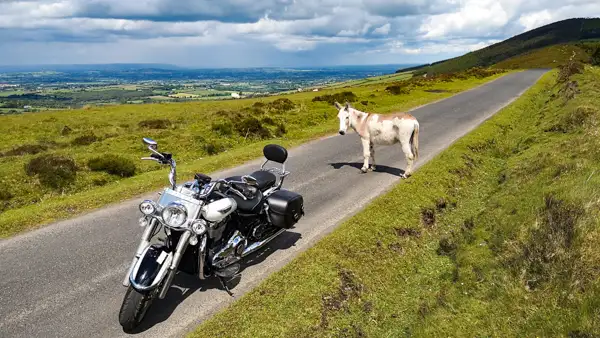
The small north-western tip of the Irish island, the old province of Ulster, has remained in the United Kingdom and has only partial autonomy as the state of Northern Ireland, like Scotland. Here, too, driving is on the left, but according to English, or British, law. Distances are measured in miles, speeds in miles per hour.
As the border between the Republic of Ireland and Northern Ireland is completely open, you do have to pay a bit of attention in the border area to where you are and how to read the speed limit signs.
Back to Ireland (Republic): So we drive on the left side of the road. On cars, to make matters worse, the steering wheel is on the right and the gears are changed with the left hand – anyone coming from the continent and getting into a rental car for the first time at Dublin Airport will get in on the left and wonder about the missing steering wheel…quite normal.
Motorcyclists have it much easier, because here all the controls are in their usual place – very good!
2) Direction of travel, overtaking and turning
In Ireland, driving is on the left, i.e. on the left-hand side of the road. On multi-lane roads, e.g. developed national roads (comparable to federal roads in Germany), or on motorways, driving on the left is compulsory.
When turning left, you turn from the left lane into the new left lane – this side quickly becomes second nature.
When turning right, you have to be more careful to choose the new left lane when turning right and not pull over to the right side out of old habit.
At intersections, yellow “boxes” are often marked on the ground; these must be kept clear.
Overtaking is always on the right, both on rural roads and on motorways.
There are exceptions to this:
If vehicles are on the road when turning right in the direction of travel, you may also pass them on the left.
In columns on multi-lane roads or on the motorway, the left-hand column may also pass on the left (of the right-hand column) if it is faster.
3) Start up/drive off
So get on, start the engine, and then? As children, we first looked to the right, then to the left. Unlike what we are used to, we learn to look right-left-right when crossing the road, right?
In Germany it does, but in Ireland it’s the other way round: here, the vehicle coming from the right reaches us first because it’s in the left lane: So look right-left-right, then drive off – onto the left side of the road!
Remember: LOOK RIGHT – DRIVE LEFT!
Attention when starting / driving off from parking lanes:
If you stop in a left-hand parking lane and then drive off again later, you have a good chance of remembering that you are driving off in the left-hand lane.
Parking lanes on the right-hand side of the road are more dangerous, because here there is a danger of driving off to the right in the old habit, i.e. in the right lane and into oncoming traffic! You have to be especially careful here! It always helps to let a few cars pass first and to look at them consciously in order to then drive off correctly (in the left lane).
4) Right of way
In Germany and on the European continent, the following applies everywhere where the right of way is not specifically regulated: RIGHT BEFORE LEFT. This is also the case in Ireland! Despite left-hand traffic! There is NO left-before-right. In Ireland, too, it is RIGHT-BeFORE-Left.
However, you seldom have to think about this, because the right of way is usually regulated at intersections, or there are roundabouts where the right of way is also regulated.
Right-of-way signs and markings generally look similar to what we are familiar with. The right of way sign and the stop sign are comparable, the right of way eight sign has an additional lettering in the middle (“Yield” or in Gaelic: “Geill Sli”). The Right of Way sign usually has a dashed line across the road, the Stop sign has a solid line. On small roads in the countryside, signs are not always clearly visible (overgrown), but the lines on the road are often still recognisable.
Traffic lights and light signals are again comparable to those in Germany.
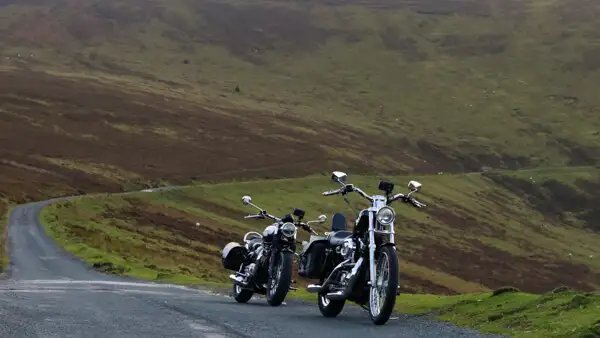
5) One-way streets
One-way streets function as in Germany, the signage is quite self-explanatory. In addition to the signs, there are also road markings where entry in the wrong direction is prohibited: The dashed line means free entry from that direction. The solid line means no entry from that direction.
6) Markings on the road
Again, similar to Germany: If lanes are marked with dashed lines, it is allowed to change lanes, but not with solid lines. If there is a dashed line and a solid line, you may change lanes coming from the side of the dashed line, but not from the other side.
7) Roundabouts: lane, flashing lights and right of way
Roundabouts are extremely common and can be very large and multi-lane, or little more than a dot in the middle of the intersection.
The roundabout is entered to the left, then the roundabout is passed through in a clockwise direction, and then the roundabout is exited to the left.
In most cases, multi-lane roads also lead to multi-lane roundabouts. Before entering the roundabout, get into the correct lane.
Left-turners (9 o’clock) should get into the left-hand lane and signal on the left.
If you want to go straight ahead (12 o’clock), you can usually get into the left or centre lane. Shortly before leaving the roundabout (to the left), turn left.
If you want to drive to the right (3 o’clock), get into the right or middle lane. Blink to the right first, and then to the left shortly before leaving the roundabout (to the left).
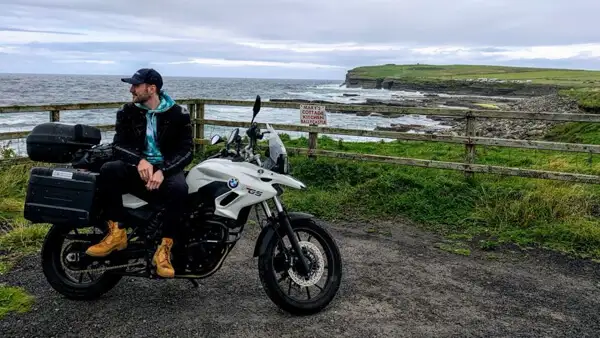
8) Motorways: Driving up, driving down, overtaking
On motorways, drivers should approach from the left, so look to the right and signal.
When leaving the motorway, turn left and signal.
On- and off-ramp lanes in Ireland are usually very long, so you have plenty of time to change lanes.
There is a general rule of driving on the left on the motorway. Overtaking is done in the right-hand lane.
Practical tip: If you drive around Dublin in the city ring road, you will notice that cars that want to get on or off the motorway quickly use the left lane, where it can get busy or even hectic if there is a lot of traffic. Those who want to stay on the city motorway for a longer time often use the quieter middle lane.
9) Parking and parking bans
In principle, the signage is self-explanatory. A special feature are solid yellow lines at the roadside:
A solid yellow line means temporary parking prohibition. The times for this can be found on a sign next to it.
Two solid yellow lines mean permanent parking prohibition.
10) Alcohol and mind-altering substances
The alcohol limit in Ireland is 0.5 per mille, except for novice drivers, for whom it is 0.3 per mille. The penalties for exceeding this limit can quickly become very expensive – even for tourists.
The same applies to drugs, medication and other mind-altering substances, i.e. draconian penalties.
So be careful on your motorbike trip with visits to breweries and whisky distilleries! Tasting can quickly become expensive and the Garda (traffic police), also know where to check.
The same applies to the evening’s fun pub visit, and also the residual alcohol the next morning – be careful!
11) Speeds in the Republic of Ireland
Unless otherwise signposted, the following speed limits apply:
Motorway = Motorway, marked “M” (M5) on blue signs: 120 kmh.
“National Roads”, marked “N” (N81), green signs: 100 kmh
Country Roads = Regional Roads, marked with R or L (L8715), white signs: 80kmh
In city traffic: 50kmh
Practical tip: Many tourists try to drive 80kmh on small R or L country roads and get terribly stressed: On many roads 70kmh or 60kmh are realistic speeds, so have no inhibitions about driving slower than is allowed.
12) Speeds in Northern Ireland
In Northern Ireland, distances are measured in miles and speeds are measured in miles per hour or mph.
Unless otherwise signposted, the permitted speeds are:
Highway, motorway: 70 mph, approximately 110 km/h.
National/country roads: 60 mph, equivalent to about 95 kmh
City traffic: 30 mph, equivalent to about 45 kmh
When driving from Ireland (Republic of) to Northern Ireland, the border is often barely visible, so you have to pay close attention to notice the change in signage.
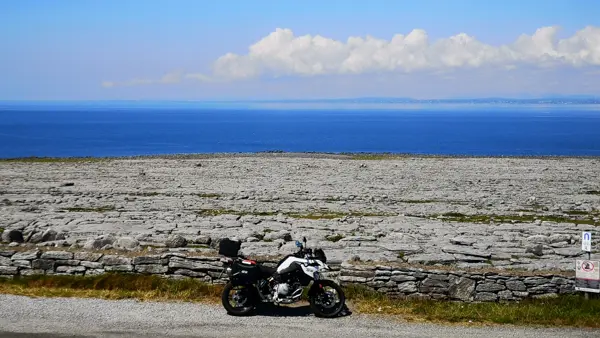
13) Emergency call and recovery assistance (towing)
If something does go wrong and there is an accident, you can call 911 or 112 in Ireland.
In Northern Ireland, only 999 is the emergency number.
If the motorbike has to be recovered, you can call the AA, which is the Irish equivalent and partner of the German ADAC. The emergency number of the AA is: AA breakdown +353 1 649 7460.
14) Special features in the countryside
Many small country roads are confusing. Hedges and walls restrict the view into the bend, entrances into meadows and fields are hardly visible and obstacles appear suddenly and unexpectedly. The only thing that helps here is to drive slowly and carefully.
The numerous hedges are trimmed a few times a year. This usually happens in spring or autumn, when no birds are nesting in the hedges. The tractors with their implements are not always well secured.
Sometimes there is someone at the side of the road directing traffic with (more or less understandable) hand signals, sometimes there are temporary signs and sometimes nothing at all. Attention at these mowing points, overtaking is often confusing.
Construction sites are also often regulated with hand signals, or green and red signs.
In the countryside there is agriculture and where there is ploughing, roads also get dirty – the mud is then preferably in the middle of the bend, not recognisable beforehand – so look ahead and drive carefully, especially in bends.
Sheep, cows, deer, dogs, horses and donkeys – it is unbelievable what cavorts on Ireland’s small country roads – and not at all rare.
In nature reserves, animals are allowed to run completely free and elsewhere the fence is broken – if you see animals, slow down considerably and be very careful, because you never know when they will run off and where.
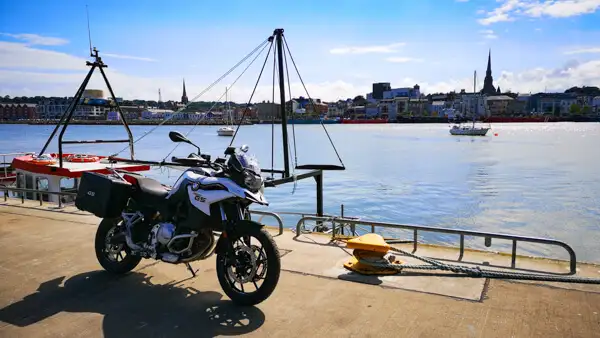
15) General consideration in traffic
Dublin is a big city with hectic traffic, not much different from big German cities.
But everywhere else in the countryside and in the many small towns and cities, the clocks tick much slower.
You hardly hear any honking, if someone takes what feels like 5 minutes to turn off, everyone waits patiently. For the unsafe granny, or even the unsafe tourist, the intersection is closed if necessary and everyone is sorted out with hand signals.
People let each other pass at bottlenecks and greet and thank each other with hand signals.
Irish people often wait for your signal whether they are allowed to overtake you – one blink to the left and they pass with thanks. By the way, on large national roads there is often a very well-developed hard shoulder for this purpose – the slower vehicle drives there to let the car behind pass.
Most tourists are happy about the hospitality and friendliness of the Irish. I think it’s a good move if you, as a traveller, return the kindness and drive considerately. And yes – saying thank you once more doesn’t hurt “reserved” Germans either!
By the way, Irish motorcyclists often don’t greet with their left hand, but with their right foot – makes sense, doesn’t it?
More interesting articles for you
15 TIPS FOR BOOKING ACCOMMODATION IN IRELAND
WHY GO TO IRELAND OF ALL PLACES? – 9 GOOD REASONS FOR A TRIP TO IRELAND
CLIMATE AND TRAVEL WEATHER IN IRELAND – WHAT YOU SHOULD KNOW FOR YOUR HOLIDAY
IRELAND TRAVEL FAQ
Photo credits cover photo: Motorcycle at the south-western coast of Ireland, photo by Ulrich Knüppel-Gertberg (www.irland-insider.de, www.ireland-insider.com)
Sources:
Roads Safety Authority (Ireland): Rules of the Road, dated 7 June 2019. Available at www.rsa.ie.
For Northern Ireland, the applicable regulations are taken from the website www.nidirect.gov.ie under the keyword “rules of the road”.
Both sources are state institutions of the respective governments.
Another source is the AA, comparable to the German ADAC: www.theaa.ie.